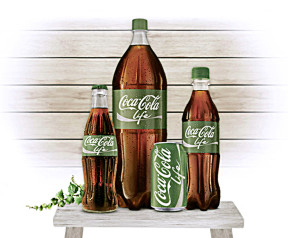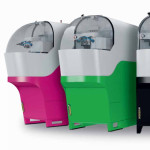Coca-Cola goes green with environmentally friendly bottle
 They’re only available in Argentina at the moment, but any success will surely spread the concept of Green Coke to the global marketplace. Marketed as Coca-Cola Life, the plastic bottles are made from 30 percent plant-based plastic and they are fully recyclable. With its 108 calories per 600 ml bottle, the drink itself sits somewhere between Diet Coke (0 calories) and classic Coke (250 calories) thanks to its partial use of the sweetener stevia alongside sugar.
They’re only available in Argentina at the moment, but any success will surely spread the concept of Green Coke to the global marketplace. Marketed as Coca-Cola Life, the plastic bottles are made from 30 percent plant-based plastic and they are fully recyclable. With its 108 calories per 600 ml bottle, the drink itself sits somewhere between Diet Coke (0 calories) and classic Coke (250 calories) thanks to its partial use of the sweetener stevia alongside sugar.
A massive change is in the design, too. Gone is the iconic red background carrying the white script logo; it is replaced by a new green tone to drive home the environmental message they’re trying to convey. It’s debatable how much the colour green signifies such issues anymore, though. We still use green petrol pumps for our unleaded petrol, even though leaded petrol is no longer available – and unleaded petrol is not exactly endorsed by Friends of the Earth. However, Coke’s push for environmentally friendly packaging could have a huge impact on the already troublesome amount of plastic littering the planet.
The biggest risk perceived by anyone who knows the history of Coke is a repeat of the 1985 New Coke affair, which proved to be a watershed moment not only in Coca-Cola’s history, but in the way changes are implemented (or foisted upon customers in this case). To summarise, the Coca-Cola Company thought after 99 years of the same recipe it was time for a change to reflect modern tastes. The public hated the decision and bombarded Coca-Cola offices with complaints and boycotted the new product. In popular retellings, two details are often left out of the run-up to the change. First, Coke had been losing market share for 15 years and so, the company reasoned, some change was required to refresh the brand. Second, there was much research into the new recipe, and the results of extensive blind tests had shown conclusively it was preferred over the old.
So what went wrong? The fact Coke was 99 years old probably played a major role in the story. It had survived two world wars and predated the admission of the state of Nebraska into the USA, so there was a sense of public ownership of the drink (even though the recipe was secret and the company private). That it wasn’t even allowed to reach the centenary rankled with some. Overall it was seen as an example of meddlesome corporates sticking their fingers into American culture for no particular reason.
Oddly enough, the protests started to get the company air time. Pressure groups were started with names like “The Society for the Preservation of The Real Thing”. Protestors picketed the company’s offices with placards which, to modern eyes, would look suspiciously like some kind of viral marketing ploy initiated by the company itself: “We want the real thing”; “Our children will never know refreshment”. Within a couple of months the Coca-Cola Company had got the message and were producing their old-style cola, branded Classic Coke, which they sold alongside New Coke, giving their customers a choice they probably would have appreciated in the first place. New Coke hardly stood a chance, and it was discontinued soon after.
Coca Cola is at the changes again, though this time in keeping with the need to be environmentally friendly. In Colombia, a supposedly green initiative is being tried by the company – bottles made entirely of ice. Water is poured into silicone bottle-shaped moulds and it’s frozen. The bottles aren’t sealed, though. They are sent to vendors empty and they fill them with cola just as you’d get cola in a glass at a bar.
You do have to question the green credentials of a product that requires energy to keep it frozen. In all likelihood (and judging by the almost identical coverage it’s getting over multiple news outlets), it’s more of a PR and marketing exercise, altough it does cut down on the need to use the plastics which are clogging landfills across the globe.
It’s impossible to understate the importance of making our bottled drinks greener. According to a Cultureist statistics, 30 billion plastic bottles go into landfills in the US alone, and three times as much water is required to produce one bottle as the capacity of the bottle itself. Although much plastic is now recyclable, it is generally not biodegradable, which means the stuff that goes into landfill will still be recognisably bottle-like in hundred of years, and fragments will survive for thousands, putting potentially toxic chemicals into water supplies and getting into the food chain.
Of course, this isn’t just Coca-Cola’s fault – it’s a global problem, and like it or not, the ultimate responsibility lies with the buying public. Given the choice, many of us will choose the greener option, all other things being equal. The problem is all else is not equal. If Company A goes green but you prefer the produce of their competitor Company B, you’re probably marginally less likely to bother too much about Company B’s green credentials. The more scientists research plastics, the more “natural” alternatives we find. Starches are a good place to start, but all manner of proteins, cellulose, vegetable oils, triglycerides, and bacterial polyesters have been found to contain the polymers essential to the production of plastics. Not only are they biodegradable over short periods of time, they generally require much less energy to produce than traditional plastics (much of which comes from oil) and their raw materials can often be grown locally.
The Coca-Cola Company naturally has to tread a careful path between commercial viability and fulfilling any green aims, so it makes sense to launch Life in a single market and maintain the original product alongside it. Even if the beverage itself proves to be a flop, they’ll have gained much experience in the production of these new greener bottles to go global with them – which hopefully wouldn’t cause anything like the 1985 backlash.
By Alex Morris
Source: AllBusiness








